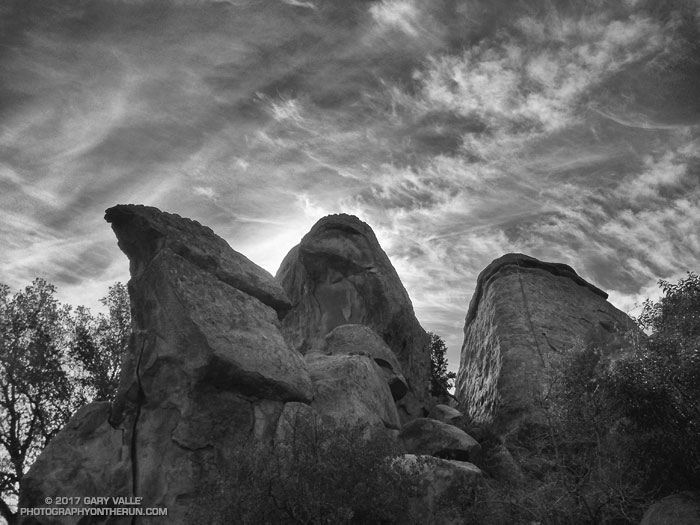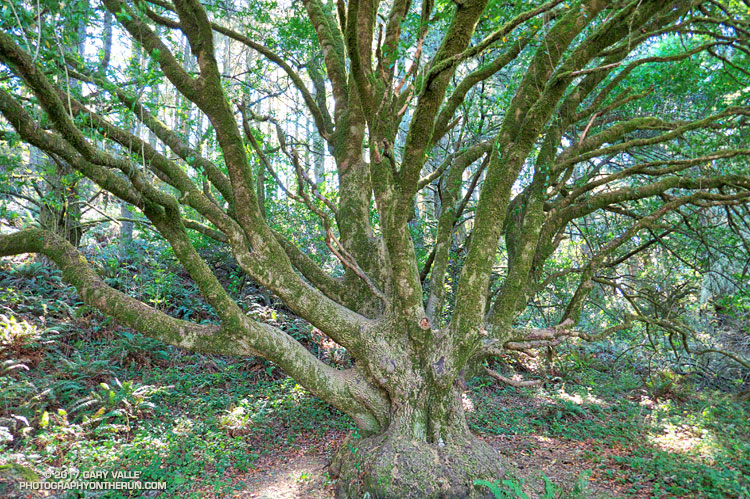
A sprawling coast live oak along the Sky Trail in Point Reyes National Seashore. From the run to Kelham Beach from the Bear Valley Visitor.

A sprawling coast live oak along the Sky Trail in Point Reyes National Seashore. From the run to Kelham Beach from the Bear Valley Visitor.
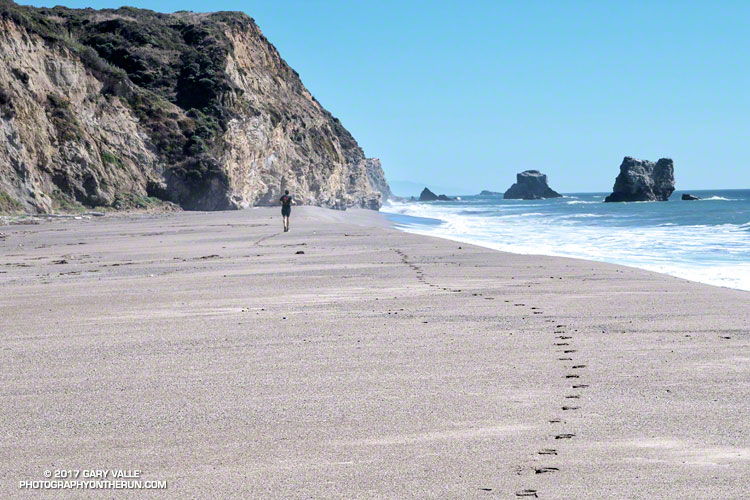
The sand was compact, the breeze cool, the surf up and the running oh so pleasant. Brett and I were running south along Kelham Beach, an idyllic stretch of sand between Point Resistance and Miller’s Point within Point Reyes National Seashore. If the tide was not too high we hoped to reach an area of dramatically folded strata along the 150′ tall sea cliffs.
Our adventure had started with a short run from the Bear Valley Visitor Center to a spot on the San Andreas Fault where a fence was reconstructed to illustrate how the Point Reyes Peninsula lurched 16 feet to the northwest during the 1906 San Francisco earthquake. Fences and roads in the Point Reyes area built across the fault trace were offset by as much as 20 feet during the earthquake.
It is the San Andreas Fault that makes the story of the Point Reyes Peninsula so unusual. A glance at a geologic map shows the rocks of the peninsula to be geologically distinct from those on the other side of the San Andreas. Essentially the Point Reyes Peninsula is an island on the margin of the Pacific Plate that is sitting against the North American Plate. The San Andreas Fault is the boundary between the two plates.
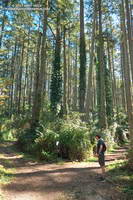
The core of the Point Reyes Peninsula is a granite similar to a granite found in Southern California. Over many millions of years the chunk of crust was propelled northward along the San Andreas Fault by the movement of the Pacific Plate. The story is not a simple one, involving a combination of faults. At some point — perhaps near current day Point Lobos — the granite core was overlain by the sedimentary rocks we see on the peninsula today.
It seems likely that at times during its 10 million year journey northward from Monterey, the Point Reyes Peninsula may have been separated from the coast. With more than 80% of its perimeter currently bounded by water, it may once again become an island.
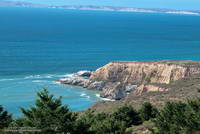
After visiting the fault zone we ran across the Point Reyes Peninsula to the coast using the Bear Valley, Mt. Wittenberg, Sky and Coast Trails. For the most part the trails were duff-covered, tree-lined, shaded and cool. For someone that runs mostly in Southern California this was practically nirvana. The previous Saturday I’d run a 50K race on a rocky, exposed course near Los Angeles in 90 degree temps and gusty Santa Ana winds. In the West San Fernando Valley the temperature this year has reached at least 95 °F every month from March through October. In July, August and September the highest temp each month was over 110 °F!
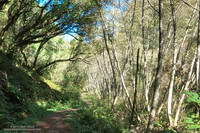
It was not 110 °F now. It was about 60 ocean-conditioned degrees. Brett and I had reached the first point where the beach narrowed. There was still room to run, but the beach narrowed even more ahead. We watched as a large wave broke and washed up to the rocks. It looked like the tide was going out, but we weren’t sure. Although the surf wasn’t huge, there was a consistent swell of maybe 6′-8′.
In between sets we took a look around the next corner and it looked sketchy. Debating, we watched as more waves washed up to the base of the cliffs. That part of the exploration would have to wait until another day with a lower tide!
Related post: Point Reyes – Sky Trail Keyhole Loop
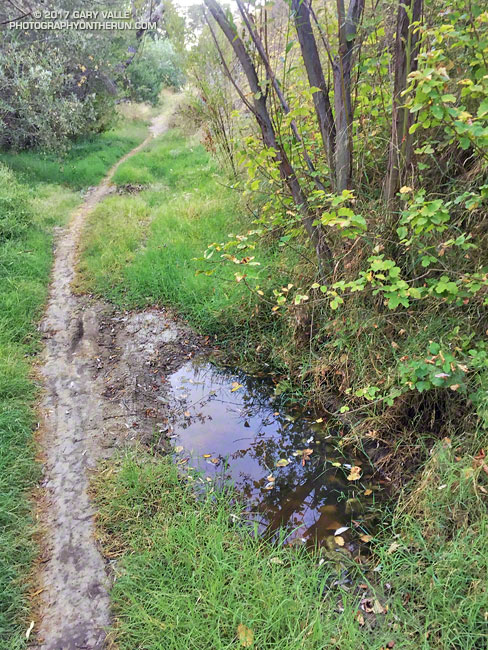
The groundwater in upper Las Virgenes Canyon appears to have been replenished by the above normal rainfall last rain season.
The little spring pictured above has persisted through the dry season and farther up the canyon a tiny stream has trickled defiantly through the Summer. The mainstem creek in upper Las Virgenes Canyon isn’t flowing as it was during the Winter, but the sand at the crossing near the Cheeseboro connector trail remains damp.
It shouldn’t take a huge amount of rain to get the creek flowing again. We’ll see!
Related post: Los Angeles Rainfall Above Normal, But…
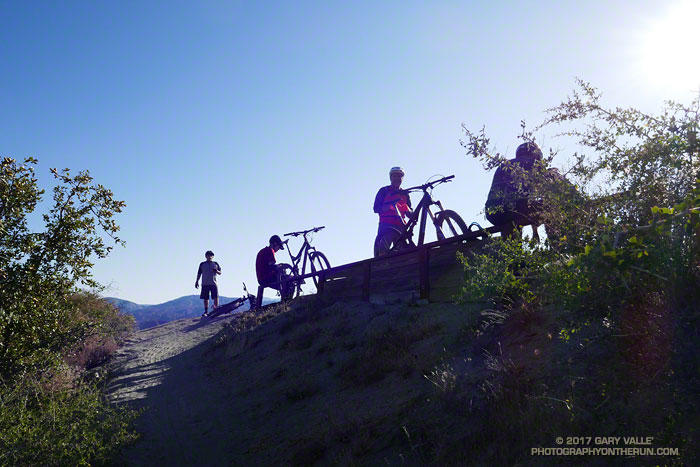
The group of five mountain bikers first passed me at Strawberry Potrero, a picturesque area on the north side of Strawberry Peak. The circuit around Strawberry Peak is a favorite of MTBers and in recent years I’ve encountered bikes on the loop nearly every time I’ve done it. It’s also an excellent run and part of the Mt. Disappointment 50K course.
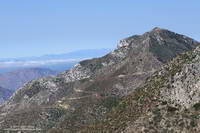
The trail segments that make up the usual loop are Josephine Fire Road, Strawberry Spur Trail, Colby Canyon Trail, Strawberry Peak Trail, Gabrielino Trail, and Nature’s Canteen Trail. Today, I was doing a variation of the circuit that swapped out some fire road for trail. Instead of parking at Clear Creek, and running up Josephine Fire Road, I parked at the Colby Canyon trailhead and ran up the Colby Canyon Trail. This variation joins the usual course at Josephine Saddle** and continues around the peak. (Another option climbs over Strawberry Peak.)
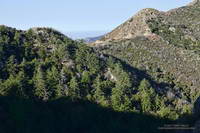
I thought I’d seen the last of the mountain bikers, but found them taking a break near the beginning of the two mile, 750′ climb to Lawlor Saddle. We chatted about the great weather and the next section of trail. As I turned to continue, one of the riders asked, “Hey, do you need a GU or anything?” I told them I was good, and started running.
Mountain bikers expect to be faster than a runner — and they usually are — but there are certain situations where runners have an edge. This was one of them. The first half-mile of the climb to Lawlor Saddle is relatively steep. After that the trail backs off a bit, but is still a decent climb. Since I had a head start, I decided to play the “How Long Can I Stay Ahead of Them” game.
I didn’t know if they were going to play or not, but it really didn’t matter. It was a way of having a little fun and motivating myself to push a little harder and run a little faster.
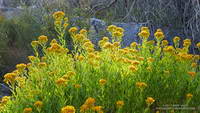
Whether you’re doing the Mt. Disappointment race or not, the climb to Lawlor Saddle will tell you if you are having a good day or bad. Today I was having a good day. The temperature was about 30 degrees cooler than at this year’s Mt. D, and after the initial steep section I ran nearly every step to Lawlor Saddle. A couple of times I thought I heard the bikers behind me, but somehow made it to the saddle without being tagged.
But now I was in trouble. Just past Lawlor Saddle the uphill ends. The question wasn’t if they would catch me, but when. Just before the trail turned to the east I caught a glimpse of a bike at the saddle, so the when might be in just a few minutes. It would depend on how spread out the riders were and if they decided to take another break.
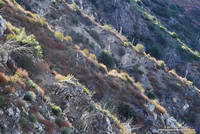
From Lawlor Saddle the trail contours around the south side of Mt. Lawlor for a mile or so, winding in and out of one ravine after another. It’s not particularly technical, but I hoped the frequent turns might slow a bike. I pushed the pace as much as I could.
About a mile from Red Box the trail finished its traverse around Mt. Lawlor and dropped down a rocky section of trail to an abandoned Forest Service road. Foolishly I started thinking maybe, just maybe, I’d make it to Red Box ahead of them.
Only about a quarter-mile from Red Box and in sight of the parking lot, I heard the tell-tale jingle-jangle of a bike bell. It wasn’t far behind me, and I moved to the side of the trail to let them pass. As the lead bike rolled leisurely past, he commented, “Hey, we weren’t sure we were going to catch you!”
The game over, I settled back in for the last few miles of the run.
Some related posts: Strawberry Peak, Switzer’s and the Old Colby Trail; Strawberry Peak Circuit; Strawberry Peak Summit Loop.
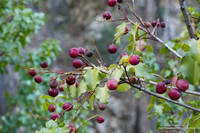
** The location of Josephine Saddle is currently mismarked on Google Earth and Google Maps. The saddle at the top of the Colby Canyon Trail has long been known as Josephine Saddle. It is marked as such on the U.S.G.S 7.5 Minute Condor Peak Quadrangles from 1959 to 2012. It is called Josephine Saddle in John Robinson’s authoritative guidebook Trails of the Angeles and numerous other guidebooks and route descriptions.
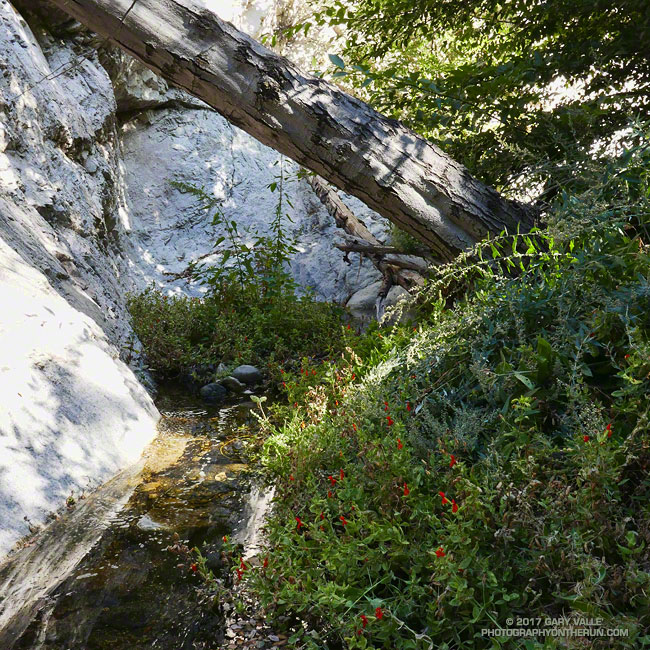
Running or hiking the Bear Canyon Trail is always an adventure. The loop from Red Box, past Mt. Disappointment, down Mt. Lowe Road, over to Tom Sloan Saddle, through Bear Canyon, and up the Gabrielino Trail is about 15-16 miles long. But it isn’t it’s length that makes it interesting.
The two miles of trail between Tom Sloan Saddle and Bear Trail Camp is isolated and little-used. The difficulty of the trail above the camp varies from year to year, and today it was a bit more challenging than usual.
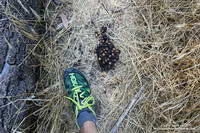
Copious Winter rain had promoted the growth of all things green in the canyon — including much poison oak and stinging nettle — and the trail wasn’t always easy to follow. Thunderstorms had recently washed away any tracks, so the only sign on the trail was bear scat and some cut trees from years past.
Because of the lush growth, fallen trees, brush, fire debris and flood debris, the trail ahead sometimes looked very improbable. A couple of times I stopped and walked back up the trail a few steps to confirm the trail was a trail and I hadn’t missed a turn. The path repeatedly crossed the creek and the creek is where the difficulties tended to be. In places the poison oak and nettle blocked the way and were not easily avoided.
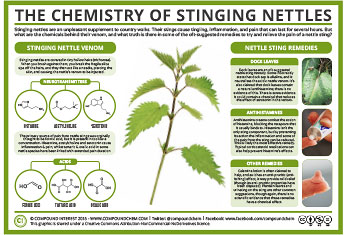
Dealing with the poison oak was easy — I just ignored it. That’s something I could worry about later. Hopefully the Technu Extreme I had in my car would take care of it. On the other hand, when you are bare-legged and bare-armed ignoring stinging nettle is a hard thing to do — contact with the plant produces instantaneous burning and stinging.
I always thought formic acid was the culprit, but apparently stinging nettle’s micro-needles contain a potent blend of chemicals that produces a poorly understood and unusually prolonged reaction.
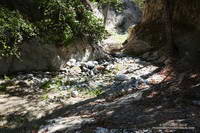
There isn’t much you can do about the burning and stinging in the middle of a run or day hike. Some say flushing the affected area with water (without rubbing) can help. If you Google “first aid stinging nettle” you’ll see various suggestions. By the time I reached Bear Canyon Trail Camp my legs felt like they had been painted with horse liniment.
The trail between the trail camp and the canyon’s confluence with Arroyo Seco is well-used and is usually in better condition than the trail above the camp. From the confluence it’s about a mile to the Gabrielino Trail, which is followed past Switzers Picnic Area to Red Box.
Some related posts: Bear Canyon Bigleaf Maple Leaves, Red Box – Bear Canyon Loop Plus Brown Mountain, Bear Canyon Loop Plus Strawberry Peak, After the Station Fire: Red Box – Bear Canyon – Gabrielino Loop
